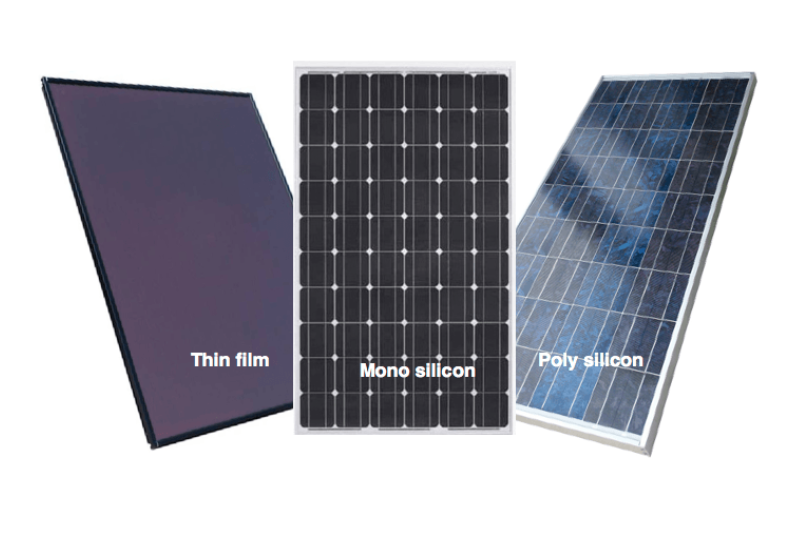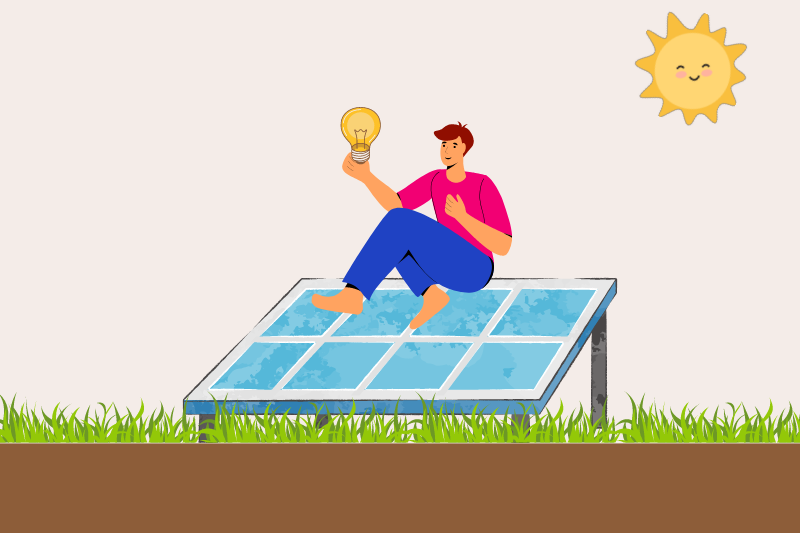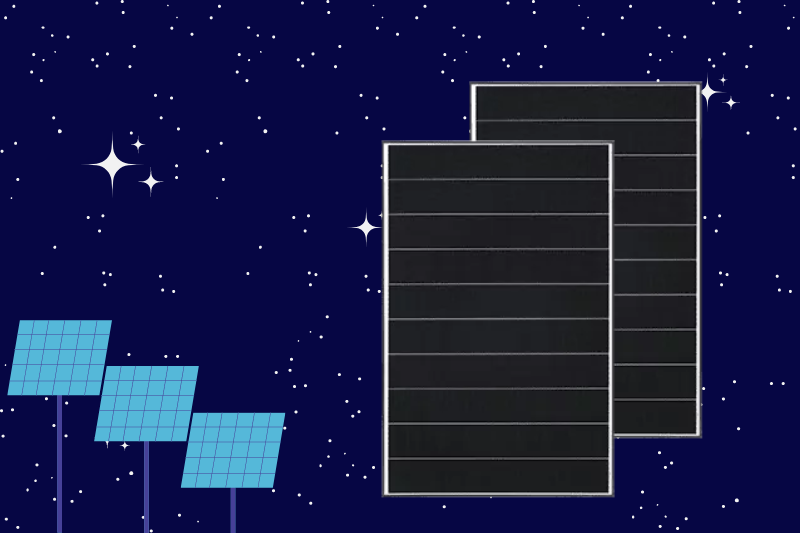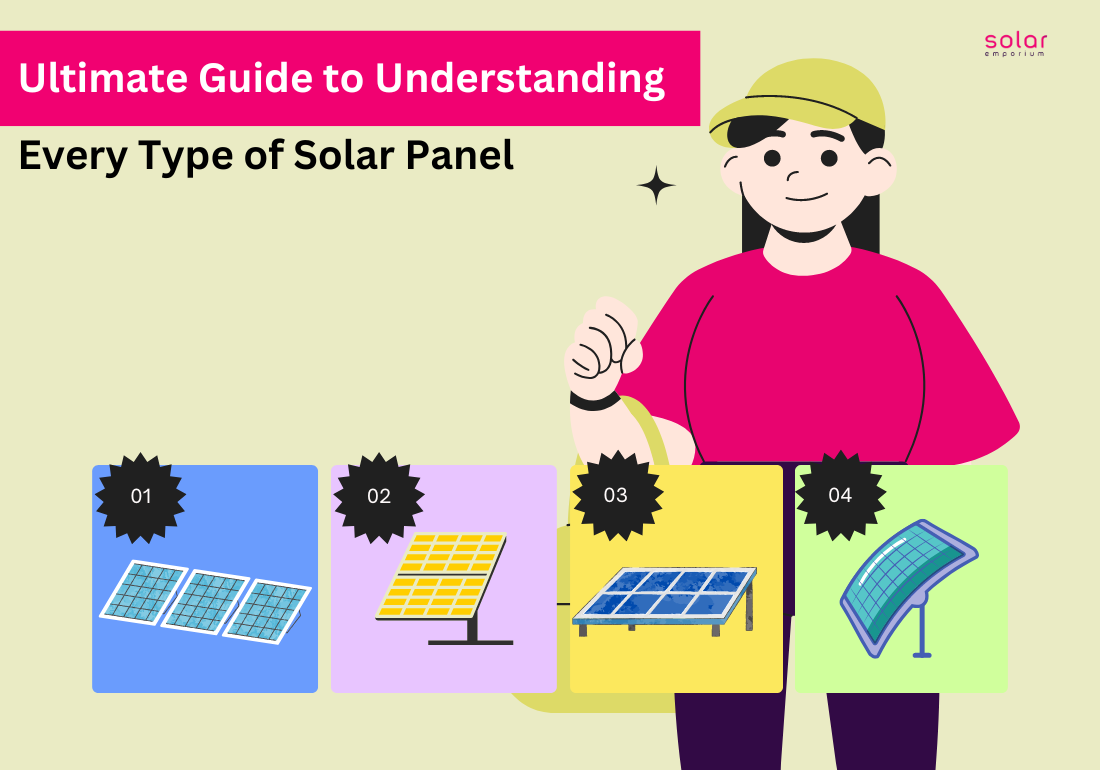Solar panels are an increasingly popular way to generate clean, renewable energy. However, with so many types of solar panels available, determining which type is the best for you can take time and effort.
This ultimate guide to understanding every type of solar panel will walk you through the different types of solar panels, their benefits, and considerations to help you make an informed decision.
You can also check out one of our previous blogs, step-by-step guide to buying quality solar panels, for a better understanding. Let’s learn more about solar energy and solar energy without further ado.
Monocrystalline:
Monocrystalline solar panels are the most efficient type of solar panel. They are made from a single, pure crystal structure, which allows electrons to move more freely, resulting in higher efficiency.
These panels are easily recognisable by their dark black colour and rounded edges. While they are more than other types, their high efficiency and longevity make them a great investment.
Polycrystalline:
Thin-Film:
Thin-film solar panels are the least efficient but the most affordable type of solar panel. They are made by placing one or more films of photovoltaic material onto a substrate.
These panels are lightweight and flexible, making them suitable for various applications, including buildings with curved surfaces or portable power systems.
Concentrated PV Cell (CVP):
Concentrated PV cells are the most efficient type of solar panel available today. They use lenses or curved mirrors to focus sunlight onto a small area of high-efficiency solar cells.
However, they require direct sunlight and a cooling system to function effectively, making them more suitable for large-scale commercial projects in sunny locations.
Bifacial:
Installing Solar Panels

Installing solar panels in Australia involves several steps and can vary depending on the type of solar panel system you choose.
Choose the Right Solar Panel System: There are three main types of solar panels: monocrystalline, polycrystalline, and thin-film. Each has advantages and disadvantages, so you must select the one that best suits your needs and budget.
Find a Certified Installer: In Australia, solar panel installation must be done by a certified installer. You can find a list of accredited installers on the Clean Energy Council website.
Get a Quote: Once you’ve picked an installer, get a quote for the installation. It should include the cost of the panels, the inverter, the mounting system, wiring, and labour.
Apply for Government Rebates and Incentives: The Australian government offers various rebates and incentives for installing solar panels. Your installer can help you apply for these.
Installation: The installer will mount the solar panels on your roof and connect them to an inverter. An inverter converts the DC electricity the panels produce into AC electricity that can be used in your home. Later, it combines the system with your home’s electrical grid.
Inspection and Connection: After the installation, the system will need to be inspected by a certified electrician. Once it passes inspection, it can be connected to the grid.
Monitoring and Maintenance: Most solar panel systems have monitoring software that tracks how much electricity your system produces and how much you use. Regular cleaning and checking the system for damage will help ensure it continues to operate efficiently.
The specifics of this process can vary depending on the type of solar panel system you choose and your specific circumstances. Consult an expert from Solar Emporium to ensure you’re getting the right system for your needs and that it’s being installed correctly.
Benefits of Solar Panels

Enjoying the benefits of different types of solar panels in Australia involves understanding each type’s advantages and how they can best serve your needs. Here’s how you can enjoy the benefits type:
Monocrystalline: These are the most efficient solar panels, producing more electricity per square metre than other types. This makes them a great choice if you have limited roof space. They also tend to have a longer lifespan than different types of panels.
Polycrystalline: These panels are less efficient than monocrystalline panels but are less expensive. If you have plenty of roof space and want to save money on the upfront cost of your system, polycrystalline panels could be a good choice.
Thin-Film: These are the least efficient type of solar panel and the least expensive. They can be a good choice if you have a lot of roof space and are looking for the most cost-effective option.
Bi-Facial: These panels generate electricity from both sides of the panel. Hence, their efficiency rates are higher than other panels.
More likely, 20 – 25 per cent higher than usual. Bi-Facial panels are also durable and aesthetically pleasing. But the panels are also more expensive than other panels.
In addition to these specific benefits, all types of solar panels can help you:
Save Money on Your Electricity Bills: You’ll start generating electricity once your solar panel system is installed. This can significantly reduce your electricity bills.
Earn Money from Feed-in Tariffs: In Australia, you can earn money from any excess electricity your system produces and feeds back into the grid.
Reduce Your Carbon Footprint: Solar panels produce renewable energy, which can help reduce your carbon footprint and contribute to a more sustainable future.
Increase Your Property Value: Installing solar panels can increase the value of your property, making it a good investment.
The best way to enjoy the benefits of solar panels is to ensure your system is properly installed and maintained. Regularly clean your panels and monitor their performance to ensure they operate efficiently.
The lifespan of Solar Panels
The lifespan of solar panels is a crucial factor to consider when investing in a solar energy system. The longevity of a solar panel refers to the period it can effectively convert sunlight into electricity at a significant efficiency rate.
The lifespan of a solar panel can be influenced by several factors, including the type of solar panel, the quality of materials used, and the conditions under which it operates.
Monocrystalline
Monocrystalline solar panels are known for their durability and long lifespan. These panels are made from a single crystal structure, which allows electrons more room to move and results in higher efficiency.
The average lifespan of monocrystalline solar panels is around 25–30 years, but they can often continue to produce electricity beyond this, albeit at reduced efficiency. Some high-quality monocrystalline solar panels have been known to last up to 40 years.
Polycrystalline
Polycrystalline solar panels are made from multiple crystal structures, which makes them less efficient than monocrystalline panels. But they are also less expensive.
The lifespan of polycrystalline solar panels is slightly shorter than monocrystalline panels, typically around 25 years. However, like monocrystalline panels, they can regularly continue to produce electricity beyond this at reduced efficiency.
Thin-Film
Thin-film solar panels are the least efficient and least expensive type. They are made by placing one or more films of photovoltaic material onto a substrate. The lifespan of thin-film solar panels is typically shorter than that of crystalline panels, averaging around 20–25 years.
But advancements in thin-film technology are continually being made, which could increase their lifespan.
The lifespan of solar panels can vary significantly depending on the type of panel and the conditions under which it operates. Monocrystalline panels have the longest lifespan, followed by polycrystalline and thin-film panels.
However, all sorts of solar panels can provide significant benefits in terms of energy savings and environmental impact over their lifespan. It’s important to consider the upfront cost and the expected lifespan when choosing a solar panel system for your home or business.
Bi-Facial
With regular cleaning, inspection and monitoring, these panels can last up to 20–25 years. Bifacial solar panels must be maintained regularly to ensure optimal performance and longevity.
Following these tips and working with a professional solar maintenance company can help ensure the panels function properly and produce the maximum energy.
Solar Energy VS Traditional Energy Sources

Solar energy is a form of renewable energy harnessed from the sun’s rays using solar panels. It is a clean, sustainable, and increasingly popular form of energy.
On the other hand, traditional energy sources primarily include fossil fuels such as coal, oil, and natural gas. These non-renewable resources have been the primary energy sources for many years.
Environmental Impact
Solar energy has a significantly lower environmental impact compared to traditional energy sources. It produces no harmful emissions or waste products and doesn’t contribute to climate change.
In contrast, the extraction and burning of fossil fuels release large amounts of greenhouse gases into the atmosphere, significantly to global warming. Additionally, the extraction processes can lead to environmental degradation and habitat loss.
Costs
The initial installation cost of solar energy systems can be high, but the running costs are very low. Over time, the price of solar energy has decreased, making it more affordable for many people.
Moreover, solar energy can significantly save electricity bills; sometimes, you can sell excess power back to the grid.
While often cheaper to set up, traditional energy sources have ongoing fuel and maintenance costs. Additionally, the cost of fossil fuels can fluctuate significantly and is likely to increase as these resources become scarcer.
Scalability
Solar energy is highly scalable. You can install a few panels on your roof to power your home and build a large-scale solar farm to power a whole community. The amount of solar energy produced is virtually limitless as long as access to sunlight exists.
Consequently, traditional energy sources could be more scalable. They require a large, expensive infrastructure to extract, process, and distribute the energy. Furthermore, the amount of energy that can be produced is limited by the amount of resources available, which is finite.
While traditional energy sources have been the backbone of our energy system for many years, solar energy offers a cleaner, more sustainable, and increasingly cost-effective alternative.
Choose Solar Emporium
As technology continues to improve and the costs continue, solar energy will likely play an increasingly important role in our energy system.
Choosing the right type of solar panel depends on several factors, including your budget, space availability, and energy needs.
Monocrystalline and polycrystalline solar panels are great for residential use, while thin-film panels offer flexibility for unique applications.
Concentrated PV cells are best for commercial projects in sunny locations, and bifacial solar panels can maximise energy production in certain setups.
Remember, investing in solar energy reduces your electricity band and contributes to a sustainable future. So, harness the sun’s power and light up your world with solar energy! And Solar Emporium is the best choice for your decision.
Solar Emporium offers solar solutions at a reasonable price. Our solar experts and solar packages allow our customers to start their renewable journey easily.







